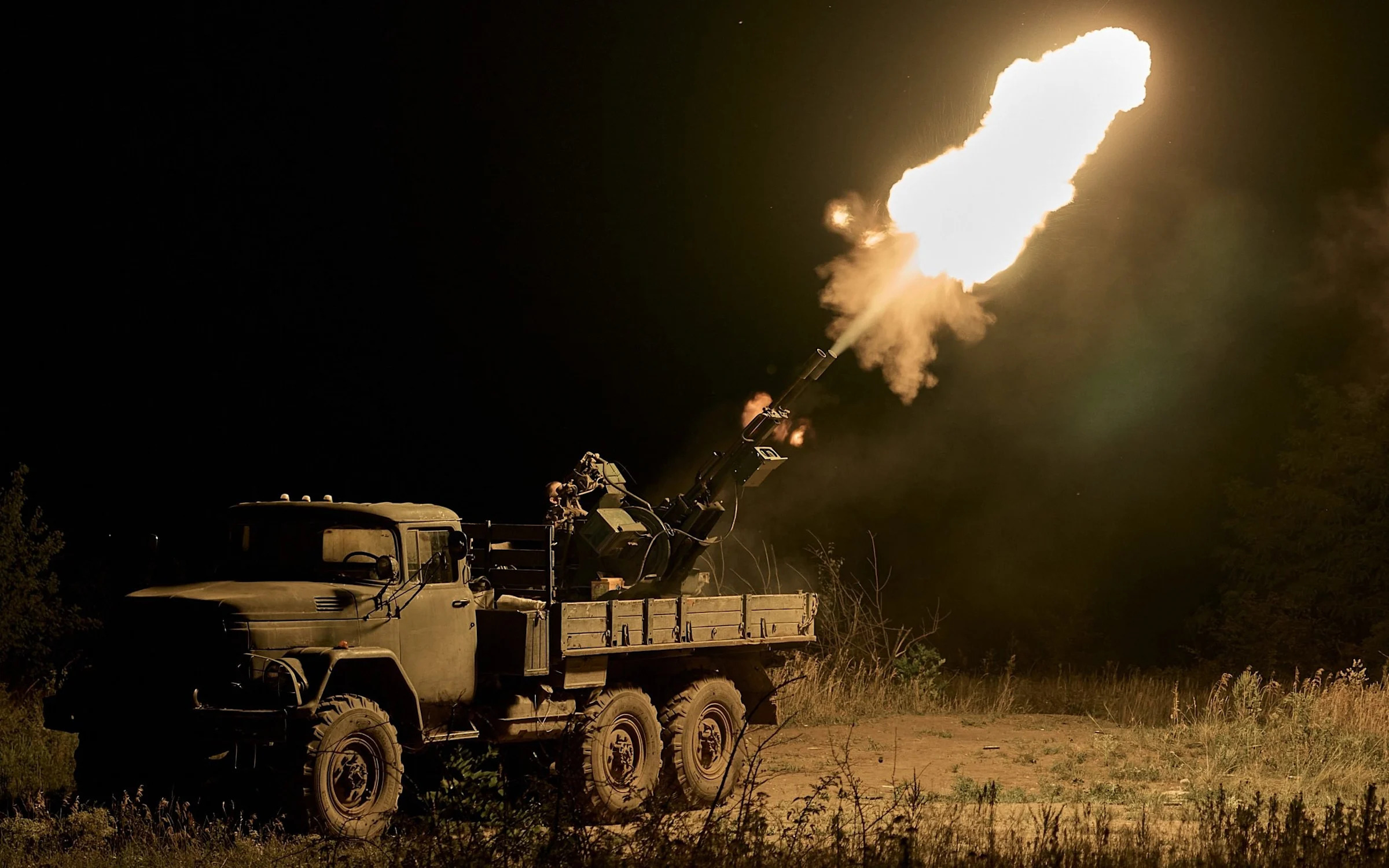On Aug 11, Russian soldiers breached Ukraine’s front-line defences and penetrated at least six miles behind enemy lines.
Battlefield maps, kept studiously up to date by open-source intelligence groups, showed a red tendril reaching north into Ukraine’s territory through several villages in the contested eastern Donetsk region coveted by Vladimir Putin, the Russian president.
The advance set off alarm bells among Kyiv’s supporters, who feared it marked the start of an offensive aimed at the stronghold city of Kostiantynivka or the logistical hub of Pokrovsk, both of which could provide Russia with a foothold in Ukraine’s fortress belt.
What Russian soldiers did not know was that Ukrainian forces had discovered the attack before the mission even began. In response, on Aug 12, Ukrainian forces began what Ukraine’s General Staff euphemistically referred to as “active measures”.
Within days of the offensive, Russian soldiers found themselves surrounded by the Azov Corps, one of Ukraine’s elite forces. The incursion, one of the deepest since the shift to attritional warfare, quickly became a costly and deadly failure.
By Aug 14, Ukraine’s military said the situation had been stabilised. According to the Azov Corps, Russian forces were pushed out of six of the villages they had captured.
Ukrainian soldiers told The Telegraph this week that the incursion was no longer cause for concern after Azov troops eliminated many of the Russian soldiers.
But as Moscow continues to send soldiers to their deaths in the name of seizing more Ukrainian land, Russia’s mission on Aug 11 offers a glimpse of what is to come on the battlefield. As with many soldiers on similar missions before them, it’s possible that these Russians knew they were going to die before the attack even began.
This grim Russian tactic has become a feature of the war as Moscow probes for weaknesses in Ukraine’s defences. Small groups of Russian soldiers are sent forward on motorcycles, dirt bikes and electric scooters without support to break through Ukrainian lines at speed
Shaun Pinner, a former British marine who served with the Azov Corps, calls these Russian tactics “suicide missions”.

Small groups of two or three soldiers push forward, slipping into cellars, houses and ruined buildings, where they wait to be reinforced by other units, all the while trying to stay hidden from Ukraine’s ever-present eyes in the sky. This, Mr Pinner said, is almost impossible.
“There isn’t one area of the front line that isn’t on a TV screen,” he said, describing a wall of surveillance. He added: “It’s almost an impenetrable ‘iron curtain’ of drones.”
Ukrainian soldiers in the area believe Russian troops managed to slip through despite this constant surveillance because of a lack of manpower, with Ukrainian forces in the middle of a rotation at the time.
Monitoring Ukraine’s extensive front line has been difficult, especially with the new threat of Russian guerrilla groups. Videos released by the 93rd Mechanised Brigade show Ukrainian FPV pilots operating drones remotely to hunt down soldiers near Dobropillia on motorcycles and on foot.
Credit: UA Land Forces / Telegram
But the situation remains fluid. Ukrainian soldiers say Russian forces are using heavy bomber drones capable of carrying up to 44lb of supplies to sustain pocketed positions and southern portions of the corridor. Some even claim that Russian troops have clawed back lost ground within the past 48 hours.
The numbers suggest the fighting was fierce. The Azov Corps reported Russian losses of 385 soldiers, 37 vehicles, one armoured fighting vehicle and a tank, suggesting the assault combined small guerrilla-style units with co-ordinated attacks.
The failed advance brought Russian positions to within six miles of Dobropillia – once a safe haven for those fleeing the embattled towns and villages of the Donbas, but now at risk of siege.
The immediate target of Moscow’s assault was clear: the Dobropillia-Kramatorsk highway, one of the most important supply routes in the Donetsk region. The road connects Dobropillia to the embattled city of Kramatorsk, serving as a logistical artery for Ukrainian reinforcements and supplies.
Control of even a short stretch would have given Moscow a chance to choke Ukraine’s movements in Donetsk and complicate Kyiv’s ability to defend its remaining strongholds in the east, while strengthening Putin’s negotiating position in talks with the US.
That Azov turned up in Dobropillia at all is noteworthy. The brigade has historically operated near Kharkiv, but its deployment here to eliminate a Russian incursion suggests the new corps structure is giving it greater flexibility.
Ukraine, it appears, is ready to send its most capable soldiers to meet Russian troops head-on, if they breach the first lines of defence.
Credit: Courtesy of 5th Separate Mechanized Brigade via Reuters
In April, the regiment was elevated to corps level and became “1st Corps of the National Guard Azov”. Ukraine’s previous structure, a Soviet legacy, left brigades operating independently even on the same front. Transitioning to a corps system allows Azov to expand its ranks, strengthen command and control, and make brigade operations more effective.
It also enables the group “to come in and sweep up the mess”, according to Mr Pinner.
One soldier stationed in the area said it was not the first time Ukraine sent in special forces for such an operation. He cited last month as another example.
“When the DRG [Russian Diversion and Reconnaissance Groups] were running around Pokrovsk, SSO [the Ukrainian Special Operations Forces] was going around at night neutralising them,” he said. “It’s good that Azov stopped them here, it would’ve been really bad if they took Dobropillia, then Pokrovsk would be lost.”
He said that more defensive pushes like this were needed. “Rodynske is the city we really need [back],” he added, referring to the city near Pokrovsk.

The timing of this most recent push from Russian forces came days before a meeting between Putin and Donald Trump, the US president, in which the Kremlin demanded that Ukraine gave up the Donbas region.
Russia occupies about 88 per cent of the Donbas, and as its summer offensive grinds on it has been making small gains.
Mr Pinner said: “While these talks are going on and there’s a chance of peace, this violence is just going to get worse.”
While small groups of soldiers carried out guerrilla-style advances in the Donbas, further south near Zaporizhzhia – another region Russia has staked out in its maximalist demands – Russia has redeployed troops for a new push, according to Gen Oleksandr Syrsky, the commander-in-chief of Ukraine’s armed forces.
He said: “The occupiers are also trying to deliver a powerful blow, which was initially planned a year ago.
“The goal is to break through our defences and advance deep into our territory. Their goal, of course, is to occupy the entire region.”
Despite these new offensives, Ukrainian soldiers told The Telegraph that such a push was not an immediate cause for concern. One said: “Things are actually cooling down in Pokrovsk.”
Mr Pinner agreed, adding: “Look how far the Nazis got before they lost the war, they got all the way to the English channel and they still lost the war – and here we are talking about a couple of kilometres.”
Yahoo News – Latest News & Headlines
Read the full article .


